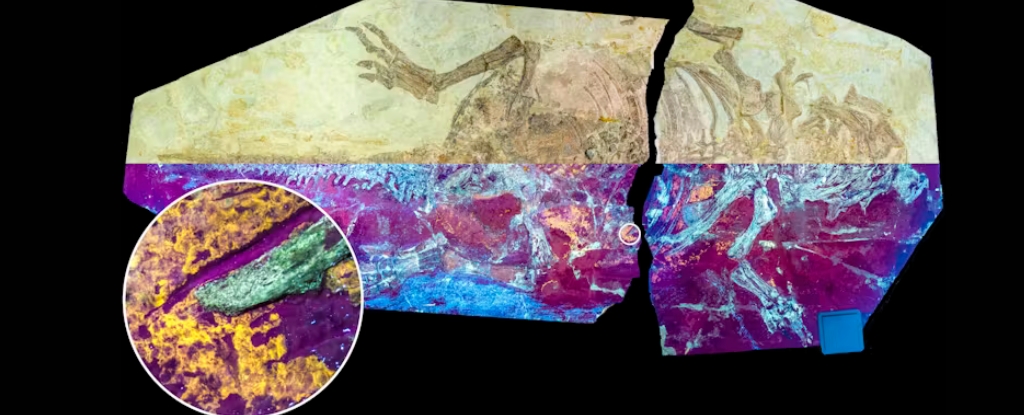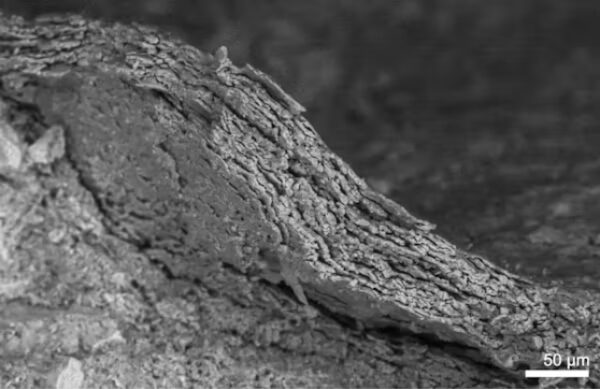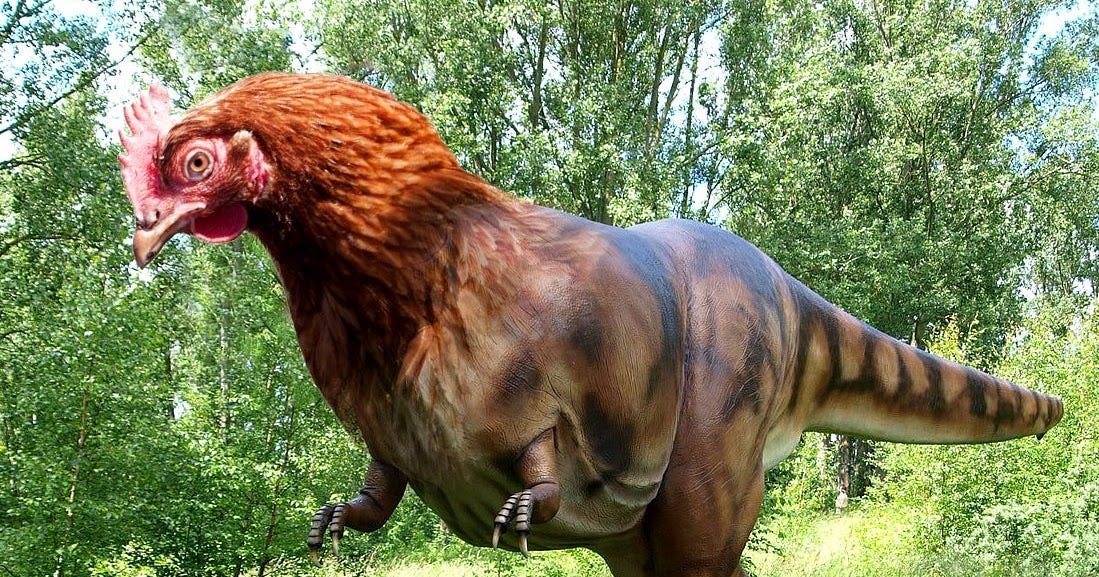Skip to comments.
'Hidden Gem' Dinosaur Skin Fossil Reveals Surprises About Feather Evolution
Science Alert ^
| May 22, 2024
| ByZIXIAO YANG & MARIA MCNAMARA
Posted on 05/22/2024 11:16:58 AM PDT by Red Badger

The studied Psittacosaurus under natural (upper half) and UV light (lower half). (Zixiao Yang, Author provided)
~~~~~~~~~~~~~~~~~~~~~~~~~~~~~~~~~~~~~~~~~~~~~~~~~~~~~~~~~~~~~~~~~~~~~~~~~~~~~~~~~
Strong but light, beautiful and precisely structured, feathers are the most complex skin appendage that ever evolved in vertebrates.
Despite the fact humans have been playing with feathers since prehistory, there's still a lot we don't understand about them.
Our new study found that some of the first animals with feathers also had scaly skin like reptiles.
Following the debut of the first feathered dinosaur, Sinosauropteryx prima, in 1996, a surge of discoveries has painted an ever more interesting picture of feather evolution.
We now know that many dinosaurs and their flying cousins, the pterosaurs, had feathers. Feathers came in more shapes in the past – for example, ribbon-like feathers with expanded tips were found in dinosaurs and extinct birds but not in modern birds. Only some ancient feather types are inherited by birds today.
Paleobiologists have also learnt that early feathers were not made for flying. Fossils of early feathers had simple structures and sparse distributions on the body, so they may have been for display or tactile sensing.
Pterosaur fossils suggest they may have played a role in thermoregulation and in colour patterning.
Fascinating as these fossils are, ancient plumage tells only part of the story of feather evolution. The rest of the action happened in the skin.
The skin of birds today is soft and evolved for the support, control, growth and pigmentation of feathers, unlike the scaly skin of reptiles.
Fossils of dinosaur skin are more common than you think. To date, however, only a handful of dinosaur skin fossils have been examined on a microscopic level.
These studies, for example a 2018 study of four fossils with preserved skin, showed that the skin of early birds and their close dinosaur relatives (the coelurosaurs) was already very much like the skin of birds today. Bird-like skin evolved before bird-like dinosaurs came around.
So to understand how bird-like skin evolved, we need to study the dinosaurs that branched off earlier in the evolutionary tree.
Our study shows that at least some feathered dinosaurs still had scaly skin, like reptiles today. This evidence comes from a new specimen of Psittacosaurus, a horned dinosaur with bristle-like feathers on its tail.
Psittacosaurus lived in the early Cretaceous period (about 130 million years ago), but its clan, the ornithischian dinosaurs, diverged from other dinosaurs much earlier, in the Triassic period (about 240 million years ago).
In the new specimen, the soft tissues are hidden to the naked eye. Under ultraviolet light, however, scaly skin reveals itself in an orange-yellow glow. The skin is preserved on the torso and limbs which are parts of the body that didn't have feathers.
These luminous colours are from silica minerals that are responsible for preserving the fossil skin. During fossilisation, silica-rich fluids permeated the skin before it decayed, replicating the skin structure with incredible detail. Fine anatomical features are preserved, including the epidermis, skin cells and skin pigments called melanosomes.
The fossil skin cells have much in common with modern reptile skin cells. They share a similar cell size and shape and they both have fused cell boundaries – a feature known only in modern reptiles.
The distribution of the fossil skin pigment is identical to that in modern crocodile scales. The fossil skin, though, seems relatively thin by reptile standards. This suggests the fossil scales in Psittacosaurus were also similar in composition to reptile scales.

A gray scale image of fossil skin cells
Layers of fossil skin cells. (Zixiao Yang/Author provided)
Reptile scales are hard and rigid because they are rich in a type of skin-building protein, the tough corneous beta proteins. In contrast, the soft skin of birds is made of a different protein type, the keratins, which are the key structural material in hair, nails, claws, hooves and our outer later of skin.
To provide physical protection, the thin, naked skin of Psittacosaurus must have been composed of tough reptile-style corneous beta proteins. Softer bird-style skin would have been too fragile without feathers for protection.
Collectively, the new fossil evidence indicates that Psittacosaurus had reptile-style skin in areas where it didn't have feathers. The tail, which preserves feathers in some specimens, unfortunately did not preserve any feathers or skin in our specimen.
However, the tail feathers on other specimens show that some bird-like skin features must have already evolved to hold feathers in place. So our discovery suggests that early feathered animals had a mix of skin types, with bird-like skin only in feathered regions of the body, and the rest of the skin still scaly, like in modern reptiles.
This zoned development would have ensured that the skin protected the animal against abrasion, dehydration and pathogens.
What next?
The next knowledge gap for scientists to explore is the evolutionary transition from the reptile-style skin of Psittacosaurus to the skin of other more heavily feathered dinosaurs and early birds.
We also need more experiments studying the process of fossilisation itself. There is a lot we don't understand about how soft tissues fossilise, which means it is difficult to tell which skin features in a fossil are real biological features and which are simply artefacts of fossilisation.
Over the last 30 years, the fossil record has surprised scientists in regard to feather evolution. Future discoveries of fossil feathers may help us understand how dinosaurs and their relatives evolved flight, warm-blooded metabolisms, and how they communicated with each other.
Zixiao Yang, Postdoctoral researcher, University College Cork and Maria McNamara, Professor, Palaeobiology, University College Cork
TOPICS: History; Outdoors; Pets/Animals; Science
KEYWORDS: beautifulplumage; dinosaurs; fakescience; feathers; godsgravesglyphs; paleontology; piningforthefjords; psittacosaurus; sinosauropteryxprima
Navigation: use the links below to view more comments.
first 1-20, 21-23 next last
To: SunkenCiv
A feather in your capon Ping!...................
2
posted on
05/22/2024 11:17:37 AM PDT
by
Red Badger
(Homeless veterans camp in the streets while illegals are put up in 5 Star hotels....................)
To: Red Badger
And God said, “Let the water teem with living creatures, and let birds fly above the earth across the expanse of the sky.” So God created the great creatures of the sea and every living and moving thing with which the water teems, according to their kinds, and every winged bird according to its kind.
3
posted on
05/22/2024 11:19:06 AM PDT
by
Raycpa
To: Raycpa
4
posted on
05/22/2024 11:22:53 AM PDT
by
Red Badger
(Homeless veterans camp in the streets while illegals are put up in 5 Star hotels....................)
To: Red Badger
I'm betting they all tasted like chicken...

5
posted on
05/22/2024 11:23:32 AM PDT
by
Magnum44
(...against all enemies, foreign and domestic... )
To: Red Badger
This will be one of the mysteries of the unknown stories on History ending with: It turns out Democrats shed their skin at that site and the scientists mistook this for dinosaur skin.” Not humans, Democrats. 🐍D
Fact:
Humans shed millions of skin cells every day, snakes and other animals shed a layer of skin in one continuous piece, a process called ecdysis, which occurs between four and 12 times a year.
6
posted on
05/22/2024 11:25:05 AM PDT
by
frank ballenger
(There's a battle outside and it's raging. It'll soon shake your windows and rattle your walls.)
To: Red Badger
What are the odds it is fake?
7
posted on
05/22/2024 11:27:51 AM PDT
by
bray
(It's not racist to be racist against races you do not like.)
To: Red Badger
8
posted on
05/22/2024 11:36:09 AM PDT
by
Raycpa
To: Red Badger
Chickens have reptile like scales on their legs and feet... and some have both scales and feathers on their legs and feet.
9
posted on
05/22/2024 11:38:20 AM PDT
by
piasa
(Attitude adjustments offered here free of charge)
To: piasa
Dinosaurs taste like chicken?........................
10
posted on
05/22/2024 11:44:46 AM PDT
by
Red Badger
(Homeless veterans camp in the streets while illegals are put up in 5 Star hotels....................)
To: Red Badger
Decisions, decisions, decisions... etc. forever.
Evolution is God’s way of presenting what he created, one living thing at a time, with changes to all those things over time... and VOILA!... we now have trillions of ‘evolved’ things that God created with his infinite number of decisions.
Not evolution. Not changes. Not mutations. All that we see and hear and touch and smell and taste and think about and work with, all came from God’s unending number of decisions. Think about all that is in our environments and even outside our environments (including all that we observe in the cosmos), and we have to come to the conclusion that, it’s all been made possible through the infinite number of decisions from God. And, he’s not finished making an infinite number of more decisions.
We can explore what God created, but, only because He ‘DECIDED” to give us the capability to ‘explore’ and learn and make changes, but even those changes are through His decision to allow us to make observations and believe that we can change things. God created us in “His” image, but only to a very limited extent.
Feather and skin “evolution”? Not even close!
11
posted on
05/22/2024 12:04:46 PM PDT
by
adorno
(CCH)
To: adorno
As you noted, this animal already had feathers and a scaly skin. Fully developed, not some halfway incomplete structures that would possibly become feathers and scales.....................
12
posted on
05/22/2024 12:07:14 PM PDT
by
Red Badger
(Homeless veterans camp in the streets while illegals are put up in 5 Star hotels....................)
To: Red Badger
It doesn’t even have feathers, it has “bristle-like feathers” - in other words bristles. There is no feather structure there at all. Neither this specimen or any other specimen of Psittacosaurus has actual feathers.
13
posted on
05/22/2024 12:14:50 PM PDT
by
fluffy
To: Red Badger
14
posted on
05/22/2024 12:37:43 PM PDT
by
sauropod
("This is a time when people reveal themselves for who they are." James O'Keefe Ne supra crepidam)
To: Red Badger
It seems to me that Bi-pedal dinosaurs would have had feathers.
And Quad-pedal dinosaurs have had fur to protect their skin from solar radiation.
But I am nobody of significance.
To: Magnum44
16
posted on
05/22/2024 5:59:58 PM PDT
by
telescope115
(I NEED MY SPACE!!! 🔭)
Selections from "feathers" and "dinosaurs" keywords, sorted:
- Wyoming Researcher Helps Discover Giant Prehistoric 170-Pound Chicken From Hell [04/01/2024]
- What color were the dinosaurs? [04/25/2022]
- Groundbreaking Study Confirms Pterosaurs Really Did Have Feathers -- And That's Not All [04/20/2022]
- Spectacular Fossil Shows a 120-Million-Year-Old Bird With a Highly Impractical Tail [09/17/2021]
- This Fossilized Skin Sample of an Iconic Dinosaur Has Revealed Jaw-Dropping Details [09/15/2021]
- Bird brains left other dinosaurs behind [07/30/2021]
- A Triassic Insect Was Found Perfectly Preserved in Dinosaur Poop For The First Time [07/02/2021]
- Fossil tracks left by an ancient crocodile that 'ran like an ostrich' [06/12/2020]
- 'Wonderchicken' fossil from the age of dinosaurs reveals origin of modern birds [03/18/2020]
- Canada Unveils 'Dinosaur Mummy' Found With Skin And Gut Contents Intact [08/25/2019]
- Rise of dinosaurs linked to increasing oxygen levels [08/22/2019]
- Baby pterodactyls could fly from birth [06/14/2019]
- Bat-winged dinosaur discovered in China [05/13/2019]
- Massive, ancient flying reptile had 'large fangs' that formed 'a toothy cage' [01/02/2019]
- Did Dinosaurs Come with or without Feathers? [01/01/2019]
- 180-million-year-old 'sea monster' found with skin and blubber [Ichthyosaur] [12/06/2018]
- Newly-Discovered Cretaceous Bird Lived Among Dinosaurs, Was Strong Flier [11/13/2018]
- The Grand Canyon's Oldest Footprints Are 310 Million Years Old [10/29/2018]
- Ticks Trapped in Amber Were Likely Sucking Dinosaur Blood [12/12/2017]
- Ticks That Fed on Dinosaurs Found Trapped in Amber [12/12/2017]
- New dinosaur looks like odd mix of duck, croc, ostrich, swan [12/06/2017]
- Hundreds Of Eggs From Ancient Flying Reptile Are Found In China [11/30/2017]
- Newfound Dino Looks Like the Creepy Love Child of a Turkey and an Ostrich [07/28/2017]
- Baby Bird from Time of Dinosaurs Found Fossilized in Amber [07/14/2017]
- Dec 2016: Feathered dinosaur tail fragment trapped in amber amazes scientists [04/15/2017]
- 'Best ever' view of what a dinosaur really looked like [03/01/2017]
- Forget what you thought dinosaurs looked like -- this adorable bird -- lizard just changed the game [09/16/2016]
- Dinosaur-like lower leg created on bird through molecular experiment [03/11/2016]
- Dinosaur egg treasure trove found in Japan [07/15/2015]
- Rapid short-term cooling following the Chicxulub impact at the Cretaceous -- Paleogene boundary [05/19/2014]
- Dinosaur Feathers Discovered in Canadian Amber [09/16/2013]
- Scientists study rare, intact dinosaur skin fossil to determine skin colour for first time [05/12/2013]
- Prehistoric Birds May Have Used Four Wings To Fly [03/14/2013]
- Asteroid may have killed dinosaurs quicker than scientists thought [02/10/2013]
- Feathery Ostrich Mimics Enfluffle the Dinosaur Family Tree [10/28/2012]
- "Beautiful" Squirrel-Tail Dinosaur Fossil Upends Feather Theory [07/03/2012]
- Jurassic Pain: Giant Flea-like Insects Plagued Dinosaurs 165 Million Years Ago [05/16/2012]
- Eggs of Enigmatic Dinosaur in Patagonia Discovered [04/21/2012]
- Dressed to kill: A feathered tyrannosaur is discovered in China [04/05/2012]
- New toothed flying reptile found from the Early Creataceous of Western Liaoning, China [03/23/2012]
- Dinosaurs had fleas too _ giant ones, fossils show [02/29/2012]
- Dinosaurs with killer claws yield new theory about flight [12/14/2011]
- 'Skin Bones' Helped Large Dinosaurs Survive for a Time, Study Finds [ osteoderms ] [12/09/2011]
- Nest Full of Baby Dinosaurs Discovered [11/20/2011]
- 'Dinofuzz' Found in Canadian Amber [09/15/2011]
- Giant fossil shows huge birds lived among dinosaurs [08/10/2011]
- Famed fossil isn't a bird after all, analysis says (Archaeopteryx) [07/27/2011]
- The rise and rise of the flying reptiles [07/06/2011]
- Rare 89-Million-Year-Old Flying Reptile Fossil from Texas May Be World's Oldest Pteranodon [03/09/2011]
- Fossilized Bird Brains May Yield Secret of First Flights [01/01/2011]
- Peerless Pterosaur Could Fly Long-Distance For Days [11/25/2010]
- Pterosaur reptile used "pole vault" trick for take-off [11/15/2010]
- Eggs with the oldest known embryos of a dinosaur found [11/13/2010]
- Study challenges bird-from-dinosaur theory of evolution - was it the other way around? [02/17/2010]
- Dinosaur True Colors Revealed for First Time [01/28/2010]
- Feathered Dinosaurs Could Glide [01/27/2010]
- Ostriches gave up flying when dinosaurs died out [01/23/2010]
- Anchiornis huxleyi: new four-winged feathered dino? [10/06/2009]
- Anchiornis: Foot Feathers Confuse Bird Evolution Story [10/04/2009]
- Cluster of dinosaur eggs found in southern India [10/04/2009]
- Origin of birds confirmed by exceptional new dinosaur fossils [09/27/2009]
- Feathered dinosaur fossils find has Chinese scientists all a flutter [09/25/2009]
- NEW DINOSAUR: Fossil Fingers Solve Bird Wing Mystery? [Dinosaur gives Creationists the finger] [06/17/2009]
- Fossil Solves Mystery of Dinosaur Finger Evolution [06/17/2009]
- The 'Birds Come First' hypothesis of dinosaur evolution [06/15/2009]
- Similar Dino Tracks Discovered In Wyoming, Scotland [06/01/2009]
- Fossil Backs Theory Linking Dinosaurs To Birds [05/06/2009]
- Fossil hints at fuzzy dinosaurs [03/19/2009]
- Oz dino bone defies drift theory [06/13/2008]
- Tests Confirm T. Rex Kinship With Birds [04/24/2008]
- T. Rex Confirmed As Great Grandaddy Of All Birds [04/24/2008]
- Ancient Flying Reptiles Likely Had Sex As Youths [03/13/2008]
- Dino-Era Feathers Found Encased In Amber (100 Million Years Old) [03/12/2008]
- Missing Link Feather Fossils Found In France [02/21/2008]
- Dinosaur research backs link to birds [04/14/2007]
- Bird wings evolved from biplane dinosaurs [01/22/2007]
- Germs Found In Amber Lived With First Dinosaurs [12/18/2006]
- Ancient Birds Flew On All Fours [09/22/2006]
- New Study Shows Tyrannosaurus Rex Evolved Advanced Bird-Like Binocular Vision [07/03/2006]
- Dinosaur poop shows grass is older than it seems [12/06/2005]
- Dinosaurs in India may have fed on grass [11/18/2005]
- Indian Dinosaurs Were Vegetarians [11/17/2005]
- Dung Reveals Dinosaurs Ate Grass [11/17/2005]
- Dinosaur-Bird Flap Ruffles Feathers [10/11/2005]
- Did feathered dinosaurs exist? [10/10/2005]
- Dinosaurs may have been a fluffy lot [09/17/2005]
- Dinosaurs may have been a fluffy lot ~~ now they tell us.... [09/06/2005]
- Reproductive riddle unscrambled [Fossilized eggs found inside dinosaur supports a link with birds] [04/15/2005]
- Early T-Rex Relative Had Feathers -- Study [10/08/2004]
- Feathered ancestor of T. rex unearthed [Transitional species] [10/06/2004]
- Dinosaur egg found in India [02/24/2004]
- World's largest dino dung - [09/07/2003]
- Dinosaur Breath - Cretaceous Atmosphere Sample obtained and Studied. [02/17/2003]
- New four-winged feathered dinosaur? [01/28/2003]
- Four-winged dinosaur makes feathers fly [01/24/2003]
- Chicks Offer Insight Into Origin of Flight [01/17/2003]
- New Study Suggests Missing Link That Explains How Dinosaurs Learned To Fly [01/17/2003]
- Dinosaur discoveries wow Boston (Wishbone discovery for older theropods) [02/26/2002]
- Fossil Strengthens Dinosaur-Bird Link [02/15/2002]
- Dinosaur eggs discovered [09/27/2001]
17
posted on
05/23/2024 5:43:31 AM PDT
by
SunkenCiv
(Putin should skip ahead to where he kills himself in the bunker.)
To: Red Badger; StayAt HomeMother; Ernest_at_the_Beach; 1ofmanyfree; 21twelve; 24Karet; ...
Thanks Red Badger.

18
posted on
05/23/2024 5:44:31 AM PDT
by
SunkenCiv
(Putin should skip ahead to where he kills himself in the bunker.)
To: SunkenCiv
So when did peach fuzz first appear?
19
posted on
05/23/2024 7:55:56 AM PDT
by
ComputerGuy
(Heavily-medicated for your protection)
To: ComputerGuy
20
posted on
05/23/2024 8:51:32 AM PDT
by
SunkenCiv
(Putin should skip ahead to where he kills himself in the bunker.)
Navigation: use the links below to view more comments.
first 1-20, 21-23 next last
Disclaimer:
Opinions posted on Free Republic are those of the individual
posters and do not necessarily represent the opinion of Free Republic or its
management. All materials posted herein are protected by copyright law and the
exemption for fair use of copyrighted works.
FreeRepublic.com is powered by software copyright 2000-2008 John Robinson






